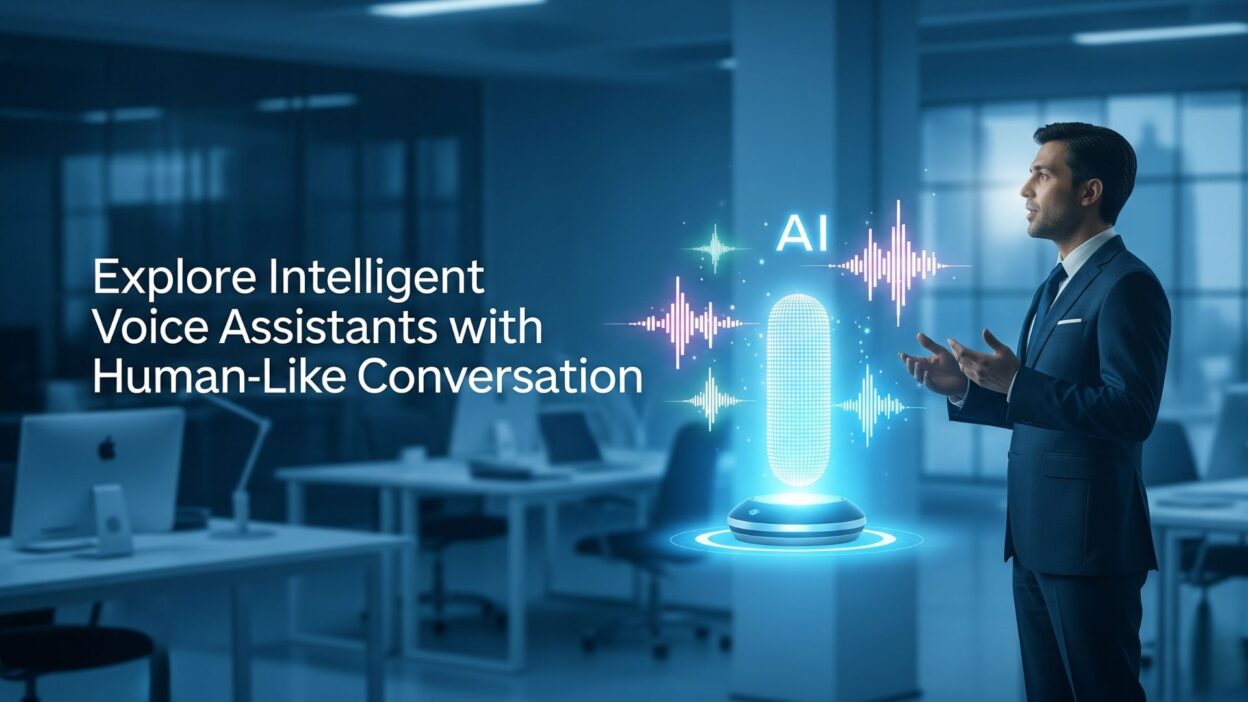TL;DR What exactly are smart voice helpers that talk like real people? How do they work? Will they really help your business run better? Is there a risk that these systems will take jobs away from humans? Let’s find out.
Table of Contents
Smart Voice Helpers for Better Customer Experience
In today’s digital world, customer expectations keep growing. More companies are using intelligent voice assistants with human-like conversation capabilities to help scale their teams with technology. Advances in artificial intelligence have made it easy and affordable for organizations of all sizes to adopt these systems. These smart voice AI applications have gained huge popularity recently as businesses seek to implement better customer service solutions.
People call these voice helpers voice AI agents. They use AI to talk like real humans on phone calls. They can understand how people naturally speak and respond to voice questions in ways that sound like actual human conversations.
Companies often build these systems for specific tasks. They use them to provide customer service or qualify leads through phone calls. They allow companies to scale almost instantly while ensuring great customer experiences.
What is a Smart Voice Helper That Talks Like Humans?
AI-powered software can talk with customers in natural conversations using voice. They are smarter versions of regular voice bots. They can understand and reply in natural language. You don’t need to program every response. They learn and respond on their own.
Think of them as digital voice assistants. They act like humans during phone calls. They handle simple and repeated tasks. Voice assistants handle these tasks through conversations.
Companies use these systems a lot to automate phone calls and voice talks with customers in customer support. A smart voice helper works as the first contact for your customer service team. It handles simple calls on its own. When calls get complex, it passes them to human agents.
These systems automate voice customer interactions. They provide support to customers 24 hours a day, 7 days a week. At the same time, they remove repetitive and slow voice tasks from your company.
While these systems replace the workload of many voice agents, they’ll never truly take the place of human support. The most efficient teams operate with a combination of human intelligence and AI systems to provide the best customer service.
These voice helpers act as virtual agents that work with your live agents to field customer voice inquiries. The AI systems can deal with routine, high-volume inquiries that would otherwise bog down live customer service agents. Human agents can use their personal touch and customer service expertise to solve more difficult queries.
This reduces costs since you’re paying for AI systems rather than hiring and training multiple human voice agents. Studies show that these systems improve job satisfaction for live agents.
AI automation reduces their workload. It helps them focus on complex and rewarding cases, which makes them feel delighted. In some cases, there is even the opportunity for them to become specialists in voice AI building and training. This both reduces employee turnover and raises the profiles of customer service teams within companies.
Overall, intelligent voice assistants with human-like conversation capabilities and voice AI agents can dramatically change how your business engages with customers through voice interactions. These systems allow businesses to streamline voice processes, quickly scale their teams, and positively impact both customer and agent satisfaction.
Smart Voice Helpers vs. Chatbots: What’s the Difference?
Smart voice systems and chatbots are often compared, but voice systems are far more advanced in voice interactions. While both can imitate dialogue, chatbots are limited by text-based scripts, whereas voice systems can engage in context-related conversations through speech.
How They Speak to Customers
Chatbots are programmed using rule-based algorithms for text interactions. This means they can recognize certain keywords in written messages and provide customers with text-based answers to those specific questions.
Smart voice systems use neural networks and machine learning. They listen to what the customer says. Then, they respond using natural speech. This helps them understand and answer questions better. Their natural language processing capabilities for voice interactions are more advanced in both voice input and voice output. When a customer asks a question through voice, these systems can recognize synonyms, mispronunciations, informal speech patterns, and casual language. When they respond, they’re able to give precise voice answers, even if they have not been explicitly programmed to respond to the exact voice inquiry at hand.
How They Provide Answers
Most chatbots are basic question-and-answer machines for text. Essentially, the customer must type the exact keyword required to receive the appropriate text answer. They use scripted text responses or direct customers to FAQ pages. If they are unable to provide an immediate text answer, there is usually a way to escalate the inquiry to a live agent.
Voice systems use conversational AI to communicate through voice in a human-like manner. A combination of natural language processing, natural language understanding, machine learning, and AI help these systems to understand a customer’s voice intent and respond through voice in a way that feels natural. These systems are often integrated into an organization’s backend systems so they can use existing data or prior voice interactions to provide context for both customers and employees. This also allows them to provide totally personalized voice responses. If and when necessary, these systems can loop in voice agents to take on difficult-to-answer voice questions or queries.
How They Learn
Chatbots are rule-based systems, so the only way for them to “learn” is by having a human create more text-based rules. They do not retain information or learn how to better answer questions based on context.
Smart voice systems that use deep learning models can learn from voice examples. This means that the more voice data you provide for your AI model, the better these systems get at recognizing what the customer wants through voice and responding to it accurately through voice interactions.
The most advanced systems can also be trained through voice interactions. Human agents can delve into voice conversations that the AI did not understand correctly and train them to recognize the voice intent the next time they encounter a similar voice conversation. This allows these systems to become particularly efficient and handle more voice inquiries as time goes on.
How Do Smart Voice Systems Work?
These systems work using a combination of different AI technologies including deep learning, natural language processing, natural language understanding, and advanced speech recognition.
Deep learning is a type of machine learning that allows these systems to get better with every voice interaction and retain contextual information from voice conversations. Natural language processing enables these systems to understand spoken language including grammar, structure, and keywords in voice interactions.
This differs from natural language understanding, which allows systems to infer the intent behind the spoken language used to derive meaning and context from voice interactions. All these technologies combine to power voice systems that can predict a customer’s voice intent and provide an appropriate voice answer the same way a live customer service agent could through voice interactions.
But even with the most advanced AI technology, these systems cannot predict what information users are looking for through voice, so it’s important to ensure the data powering your voice systems is the right content for voice interactions. Some systems use industry standard sets of data, but the best ones use your own company’s historical voice data.
Basically, every single customer support voice conversation that has occurred over the years is stored in your CRM platform. By uploading this voice data to your AI systems, the AI can cluster the most common voice topics together and thereby identify frequent customer “voice intents”. Once you’ve deciphered what your customers are most frequently looking for through voice interactions, you can create voice conversation flows to automate those types of voice inquiries.
When this process is based on your company’s historical voice data rather than pre-built data sets, you can be sure you’re addressing exactly what your customers need through voice and customize your systems’ voice dialogues to your organization’s brand personality and voice processes.
The more advanced systems are capable of learning and improving from voice interactions. A “set it and forget it” model is often easier to set up, but will result in poorer voice performance in the long run. When you can train your systems to recognize new voice intents, it means they will continue to become more and more efficient in voice interactions.
Where are Smart Voice Systems Used?
These systems are used across many industries, including ecommerce, fintech, travel, healthcare, and more. They can be especially useful for customer service teams in businesses that deal with a high volume of repetitive voice inquiries.
Using smart voice systems can also benefit companies that are particularly susceptible to rapid or unpredictable increases in voice support volume. For example, an ecommerce company that experiences huge increases in voice support tickets around Black Friday can make use of these systems to field routine voice inquiries, freeing up the human voice agents to work on what really matters.
Rapidly scaling businesses can also make use of these systems if it becomes too time consuming to hire human voice resources or if hiring human voice agents cannot provide strong enough ROI.
In general, the types of companies that use these systems tend to be B2C businesses that have existing voice contact centers that they can integrate into the platform they choose.
No matter the industry, some reasons for implementing these systems might be:
- To scale the company’s voice support team capacity
- To better serve their customer base with immediate voice support available 24/7
- To increase customer satisfaction score
- To drive more revenue
- To reduce costs related to employee churn
- To empower their customer support teams to work on challenging voice escalations instead of mundane voice tasks
The ultimate goal is always the same: to provide excellent voice support that keeps their customers satisfied while automating voice processes that help keep employees happy and save the business money.
5 Benefits of Smart Voice Systems
Introducing these systems allows businesses to dramatically improve their customer service processes. Here are some of the ways they benefit both the customer and the company.
Deliver Great Customer Experiences
Today’s customers expect and demand efficient and personalized service through voice interactions. In a recent survey of top CMOs, 71% said that buyers want a personalized experience based on their needs and preferences. Also, 74% said that buyers expect fast answers to their voice questions.
When you use systems with backend integrations, you give fast voice answers. These answers are personalized using each customer’s data and preferences. This makes the support more helpful and relevant.
Increase Efficiency
Smart voice systems allow customer support teams to save a significant amount of time and effort addressing routine voice inquiries. These systems can act as the first line of support. They help move customer voice requests away from phone calls. They also tag voice support tickets automatically, which helps reduce backlog. This lets agents focus on voice cases that truly need a human touch. This decreases wait times for everyone as well as saving costs on hiring and training live voice agents.
Improve Your Agents’ Performance Metrics
Customer Satisfaction Score, Average Handling Time, First Response Time, Net Promoter Score. What do all these acronyms have in common? Companies often use them to check how well their customer service teams are doing. Smart voice systems can help improve all areas of performance.
Companies that implement these systems often see an improvement in all of the above metrics. These systems can either resolve voice inquiries or escalate the problem to an agent with the appropriate tags and context for a person to be able to address the voice issue faster, resulting in lower handling times.
These systems can greet customers instantly through voice, resulting in extremely fast first response times. Since they increase voice efficiency overall, customer satisfaction and promoter scores tend to increase, especially as time goes on and the systems become better and better at voice interactions.
Reduce Agent Frustration & Turnover
Many agents in traditional voice contact centers spend a lot of their time handling mundane voice requests that follow similar processes, such as order tracking, returns, cancellations, etc. This can be frustrating for people who would like to handle more complex voice problems and perpetuates the age-old stereotype of call centers and customer service being a temporary job.
By letting smart systems handle these routine voice tasks, like checking dates, names, and order numbers through voice interactions, your live agents can focus on harder to solve voice issues. This results in customer service becoming a more rewarding and sought-after career field, reducing attrition rates among customer support teams.
Provide Global, 24/7 Customer Support
One huge benefit of these systems is that they can operate constantly through voice interactions. For companies that operate across time zones or around the world, this is an invaluable aspect.
You don’t need to hire voice agents around the world. These systems can give 24/7 voice support. They send harder calls to live agents during normal business hours. This helps reduce backlog and lowers the agents’ workload. At the same time, customers get voice support anytime they need it. What’s more, some systems even have the capability to deliver multilingual voice support.
This enables businesses to operate in multiple markets without having to hire as many bilingual or multilingual voice agents as they would without the systems’ support.
Examples of Smart Voice Systems in Action
Many industries use these systems to make a strong impact. Here are a few stories where they enabled better customer service:
How PreCallAI’s Voice Assistant Helped a Travel Company Navigate Peak Season
In March of 2023, a major travel company’s voice query volumes surged. Faced with an increase of 600 to 900% in voice calls, they needed to respond immediately to an influx of customers reaching out about bookings and cancellations through voice calls. Thankfully, they had already implemented PreCallAI’s intelligent voice assistants with human-like conversation capabilities for voice automation. By tweaking the voice greeting message to determine if the voice query was related to current travel restrictions, the system could direct customers accordingly through voice interactions.
They also implemented a new voice support path exclusively for refunds and cancellations in multiple languages. This resulted in a voice automation rate of 60% during peak season.
How a Fintech Company’s Voice Agent Reduced Call Backlog by 90%
A UK fintech company headed into 2023 with a massive voice call backlog and response times spanning several hours. By adding PreCallAI’s system to their voice support team, they were able to automate over 15,000 voice calls a month.
Overall, the system produced 4 times more voice output than a human agent, while implementation costs remained below two monthly salaries for voice staff.
How a Telecom Company Saves 3,500 Hours of Agent Effort Monthly
A major telecommunications corporation was seeing voice calls growing quickly—with up to 85,000 customer service voice calls occurring per month. After launching their smart voice system, they were able to automate 40% of all voice calls, saving 3,500 hours of agent effort a month (over 42,000 hours a year) during peak season thanks to voice automation.
Read More: Teaming Up AI and Humans to Improve Customer Service
Conclusion

More businesses now use voice to talk with customers. As teams grow fast, they need better ways to manage support. Smart voice assistants with human-like conversations are becoming a top choice for customer service. In fact, in a recent Deloitte Digital survey, 79% of contact center leaders said they plan to invest in greater AI capabilities in the next two years.
Industry leaders in travel, e-commerce, fintech, and beyond have already greatly benefited from these systems and will continue to do so. Voice automation is becoming common. Customers are using smart voice systems. Companies that don’t use them may lose customers. People will choose businesses that offer faster and better service.






[…] Read More: Explore Intelligent Voice Assistants with Human-Like Conversation […]
[…] body language. Brand voice consistency will expand to include visual brand personality elements. Customizable AI agents will deliver complete sensory brand […]